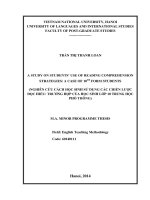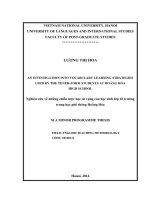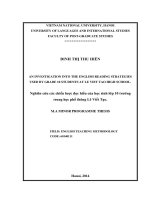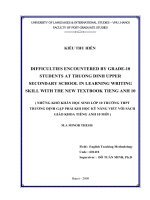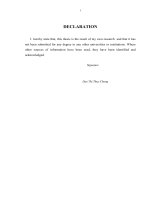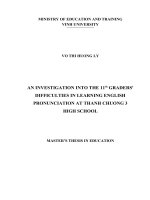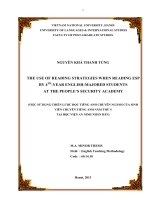An investigation into the reading strategies used by grade 10 students at Lê Viết Tạo High School = Nghiên cứu các chiến lược đọc hiểu Tiếng Anh của học sinh lớ
Bạn đang xem bản rút gọn của tài liệu. Xem và tải ngay bản đầy đủ của tài liệu tại đây (540.75 KB, 61 trang )
VIETNAM NATIONAL UNIVERSITY, HANOI
UNIVERSITY OF LANGUAGES AND INTERNATIONAL STUDIES
FACULTY OF POST-GRADUATE STUDIES
******************
ĐINH THỊ THU HIỀN
AN INVESTIGATION INTO THE ENGLISH READING STRATEGIES
USED BY GRADE 10 STUDENTS AT LE VIET TAO HIGH SCHOOL.
Nghiên cứu các chiến lược đọc hiểu của học sinh lớp 10 trường
trung học phổ thông Lê Viết Tạo.
M.A MINOR PROGRAMME THESIS
FIELD: ENGLISH TEACHING METHODOLOGY
CODE: 60140111
Hanoi, 2014
VIETNAM NATIONAL UNIVERSITY, HANOI
UNIVERSITY OF LANGUAGES AND INTERNATIONAL STUDIES
FACULTY OF POST-GRADUATE STUDIES
******************
ĐINH THỊ THU HIỀN
AN INVESTIGATION INTO THE ENGLISH READING STRATEGIES
USED BY GRADE 10 STUDENTS AT LE VIET TAO HIGH SCHOOL.
Nghiên cứu các chiến lược đọc hiểu của học sinh lớp 10 trường
trung học phổ thông Lê Viết Tạo.
M.A MINOR PROGRAMME THESIS
FIELD: ENGLISH TEACHING METHODOLOGY
CODE: 60140111
SUPERVISOR: TÔ THỊ THU HƯƠNG, PhD.
Hanoi, 2014
i
DECLARATION
I hereby state that I - Đinh Thị Thu Hiền, being an M.A. candidate of the
Faculty of Post-graduate Studies, ULIS, VNU, certify my authorship of the study
entitled:
AN INVESTIGATION INTO THE READING STRATEGIES USED
BY GRADE 10 STUDENTS AT LÊ VIẾT TẠO HIGH SCHOOL.
The thesis is the study of my own research and the substance of the thesis has
not, wholly or in part, been submitted for a degree to any other universities or
institutions.
Hanoi, August, 2014
Đinh Thị Thu Hiền
ii
ACKNOWLEDGEMENTS
First of all, I would like to express my deep gratitude and love to my
supervisor, Dr. Tô Thị Thu Hương for her guidance, comments, and especially her
encouragement throughout the whole research process.
I am also grateful to all teachers at the Postgraduate Department, ULIS,
VNU, whose lectures and guidance have contributed to my understanding of the
problem and led to the completion of this thesis. My words of thanks would also go
to the teachers who will spend their time reading and commenting on this thesis.
Especially, I wish to express my appreciation to my students grade 10 and
English teachers at Lê Viết Tạo High School, who have been really helpful and
cooperative in the implementation of the study.
Last but not least, I would also like to take this opportunity to send my love
to my family who have been encouraging and supporting me wholeheartedly.
.
iii
ABSTRACT
This study investigated the perceived reading strategies by grade 10 students
at Lê Viết Tạo High School in replication of the study conducted by Mebratu
Mulatu Bachore (2014). The population of the study comprised 180 grade ten
students and three English teachers at Lê Viết Tạo High School. The data were
obtained through not only students' questionaire consisting of 30 items probing
three categories: Meta cognitive, cognitive and Affective/social reading strategies
but also teachers‟ interviews.
On the basis of the information obtained from teachers and students‟
perceived use of English reading strategies, suggestions on how to improve English
reading for grade 10 students at Lê Viết Tạo High School are made.
iv
LIST OF TABLES
Table 1: Planning and evaluating strategies.
Table 2: Strategies of monitoring and tackling challenges of comprehension.
Table 3: Strategies of extracting and working on ideas from a text.
Table 4: Strategies of using noting features and supplementary aids.
Table 5: Guessing and deciding on ideas from a text.
Table 6: Social/ Affective reading strategies.
v
LIST OF ABBREVIATIONS
EFL: English as a foreign language
ESL: English as a second language
vi
TABLE OF CONTENTS
DECLARATION i
ACKNOWLEDGEMENTS ii
ABSTRACT iii
LIST OF TABLES iv
LIST OF ABBREVIATIONS v
TABLE OF CONTENTS vi
PART A: INTRODUCTION 1
1. Rationale for the study 1
2. Aims of the study 2
3. The research questions .2
4. Significance of the study .2
5. Scope of the study 3
6. Method of the study 3
7. Organization of the thesis 3
PART B: DEVELOPMENT 4
CHAPTER 1: LITERATURE REVIEW 4
1.1 Definition of reading 4
1.2. Reading process 5
1.2.1 Interactive model 5
1.3 The importance of reading in foreign language learning .6
1.4. Factors involved in reading comprehension 7
1.4.1.Teacher‟s role 7
vii
1.4.2 Students‟ role 8
1.4.3. The reading texts 8
1.5 Reading strategies 9
1.5.1 O‟Malley and Chamot‟s (1990) language learning strategies 9
1.5.2 Classification of Language Learning Strategies 9
1.5.3 The importance of strategies in the learning process 10
1.5.4 Reading strategies in teaching second language reading 11
1.5.4.1 Definition of reading strategies 11
1.5.4.2 Classification of Reading Strategies 12
1.5 Studies on reading strategies 15
1.6 Summary 16
CHAPTER 2: METHODOLOGY 17
2.0 Mebratu Mulatu Bachore‟s (2014) study 17
2.1 Participants 17
2.1.1 Teachers of English 17
2.1.2 The 10
th
– form students 18
2.2 Data collection instruments 18
2.2.1 The questionnaire for the students 18
2.2.2 The structured interview for teachers 19
2.3 Data collection procedures 19
CHAPTER 3: RESULTS AND DISCUSSION 20
3.1 Data analysis 20
3.1.1 Questionnaire for the students 20
viii
3.1.2 Interview 31
3.2 Discussion 33
PART C: CONCLUSION 37
1. Summary 37
2. Limitations and suggestions for further study 37
LIST OF REFERENCES 39
APPENDICES I
APPENDIX 1 .I
APPENDIX 2 VI
APPENDIX 3 VII
1
PART A: INTRODUCTION
1. Rationale for the study
To have a good command of English, students are required to master four
closely related language skills, namely listening, speaking, writing, and reading.
Among four skills, reading is considered to be the most important because it not
only provides students with knowledge but also helps develop other language skills.
According to Krashen (1993), reading is extremely important in learning English.
He emphasizes reading is the only way to “become a good reader, develop a good
writing style, an adequate vocabulary, advanced grammar”, and the only way to
“become a good speller”. That is to say, teaching and learning reading effectively is
a central issue in a language classroom.
Traditionally, researchers have agreed that reading was a passive or receptive
process in which the reader attempted to decode the intended meaning of the author
through recognizing the letters and words as meaningful units, the reader was
merely a recipient of information from the printed pages and brought nothing to the
text ( Barnett, 1988). However, modern research on reading has found the reading
process active rather than passive as well as individualized and complicated.
Many studies such as “Teaching How To Learn- Learning Strategies in ESL”
(Willing, 1989), “Teaching Second Language Reading” (Hudson, 2007), “New
Ways in Teaching Reading” (Day, 1993) and Reading Through Context: How Real
and Perceived Strategy Use Affects L2 Comprehension (Barnett, 1988) have
indicated that the use of appropriate strategies may improve reading comprehension.
My teaching experiences at Lê Viết Tạo High School have pointed out some
problems students encounter in English reading lessons. When dealing with reading
lessons, students, especially grade 10 students often lack reading strategies which
are essential for them to overcome the challenges in the classroom. Many
researchers indicate that EFL students find it difficult to comprehend the texts and
achieve their goal of reading success (Rumelhart, 1977; Stanovic, 1980). Recent
researchers have also found that becoming more aware of what readers do when
2
they read, becoming conscious of their own reading processes is a power tool for
improving reading efficiency. To become better readers, students need to become
aware of how they are reading and what they could do to improve it.
As a teacher of English, I myself think that it is essential to conduct a
research on reading strategies used by grade 10 as well as to provide them with
some efficient strategies to improve their English reading. As a result, I decide to
choose the thesis entitled: “An investigation into the reading strategies used by
grade 10 students at Lê Viết Tạo High School” for my MA Degree.
2. Aims of the study
The major purposes of this study are:
* To investigate what English reading strategies being used by grade 10
students at Lê Viết Tạo High School.
* to suggest some English reading suggestions that help students improve
their English reading comprehension.
3. The research questions
1. What English reading strategies are often used by grade 10 students at Lê
Viết Tạo High School?
2. What effective English reading suggestions could be suggested to help 10
th
- grade students at Lê Viết Tạo High School improve their reading comprehension?
4. Significance of the study
This study has been carried out to search for a better and more effective way
to develop students‟ reading skills. Its findings hopefully would help the 10th-form
students find out the suitable way for improving their reading skills. Regarding
teachers, the study would raise their awareness concerning the topic and provide
them with useful pedagogical suggestions in deciding to use the new teaching
method to better develop their learners‟ reading skills. Finally, with regard to
researchers, those who happen to share the same interest in the topic could certainly
rely on this research to find reliable and useful information for their related studies
in the future.
3
5. Scope of the study
To improve reading (skills and comprehension) for Lê Viết Tạo High School
10th – form students, the teachers can make use of various techniques and a number
of things should be done. However, in this study, the author only focuses on the
perceived English reading strategies by the 10th – form students and opinions of
English teachers of Lê Viết Tạo High School to suggest some reading strategies that
can be applied in teaching and learning English reading so as to help the students to
become effective readers.
6. Method of the study
To achieve the aims mentioned above, data were collected through the
survey questionnaire and interviews. Both quantitative and qualitative methods
were used to obtain information on reading strategies used by 10
th
– form students.
7. Organization of the thesis
The study is divided into three parts: part A: Introduction, part B:
Development and part C: Conclusion.
Part A: Introduction consists of the rationale, aims and objectives,
significance, scope, method and organization of the study.
Part B: Development consists of three chapters. Chapter 1 (Review of
literature) provides the theoretical background of the study. Chapter 2
(Methodology) describes Mebratu Mulatu Bachore‟s (2014) study, the participants,
data collection instrument/ procedures. Chapter 3 (Results of data analysis and
discussion) offers some major findings, some suggestions for improving students‟
reading.
Part C: Conclusion consists of conclusions, the limitations and suggestions
for further study.
4
PART B: DEVELOPMENT
CHAPTER 1: LITERATURE REVIEW
This chapter briefly discusses the theoretical background related to the study.
Review of aspects of reading in foreign language relevant to the study will be
included in: Definition of reading, reading models, the importance of reading in
foreign language learning, factors in teaching and learning reading, reading
strategies and summary.
1.1. Definition of reading
For English as a second/foreign language (ESL/EFL) students, reading is an
essential skill to master. There are numerous definitions of reading which range
from simple to complex ones, from readers‟ passive role to their active one.
Anderson (1999: 1) confirms that “the more exposure student has to language
through reading, the greater the possibilities that overall language proficiency will
increase”. Anderson (1999:1) defines reading as “an active, fluent process which
involves the reader and the reading material in building meaning”. Aebersold &
Field (1997:15) share the same view on reading as “reading is what happens when
a text is looked at and meaning is assigned to the written symbols in that text. The
text and the reader are the two physical entities necessary for reading process to
begin. It is, however, the interaction between the text and the reader that constitutes
the actual meaning”. Goodman (1971: 135) regards reading as “a psycholinguistic
process by which the reader, a language user, reconstructs, as best as he can, a
message encoded by a writer as a graphic display”. Rumelhart (1977) also considers
reading involving the reader, the text and the interaction between the reader and the
text. Reading is not just extracting meaning from a text but a process of connecting
information in the text with the knowledge the reader brings to the act of reading. It
is seen as an active cognitive process in which the reader‟s background knowledge
plays a key role in the creation of meaning (Tierney and Pearson 1994). Reading is
an interactive process that goes on between the reader and the text, resulting in
5
comprehension. The text presents letters, words, sentences, and paragraphs that
encode meaning. The reader uses knowledge, skills, and strategies to determine
what that meaning is. Reading can also be defined as “a fluent process of readers
combining information from a text and their own background knowledge to build
meaning. The goal of reading is comprehension…The text, the reader, fluency, and
strategies combined together define the act of reading” (Anderson, 2003: 68).
In short, each author defines reading from different perspectives. However,
most of the definitions reveal some common features, that is, the close relationship
between reading and understanding; and the reading process which involves the
reader, the text, and the interaction between the reader and the text.Therefore, being
a language teacher, we must understand the nature of reading thoroughly to help our
students read effectively.
1.2 Reading Models
Reading researchers, in the last 40 years, have been studying the link
between the reading process (what goes on in the mind of the reader) and how to
teach reading. Although there are many models of reading, reading researchers tend
to classify them into three kinds: Bottom-up, Top-down and Interactive. For the
purpose as well as the limitations of both bottom-up and top-down models, the
study only refers to the Interactive model.
1.2.1. Interactive model
Interactive model is currently accepted as the most comprehensive
description of the reading process. Grabe (1991: 378, cited in Aebersold & Field
1997:18) focuses on two conceptions of interactive approaches. The former relates
to the interaction that occurs between the reader and the text. The latter relates to
the interaction between bottom-up and top-down processes. They are occurring,
either alternatively or at the same time, which depend on the type of text, the
reader‟s background knowledge, language proficiency level.
6
Interactive model combines elements of both bottom-up and top-down
models. Murtagh (1989:102, cited in Anderson, 1999:3) stresses that the best
second language readers are those who can “efficiently integrate” both bottom-up
and top-down processes.
While reading, in order to check whether that is really what the writer says, a
reader continually shifts from one focus to another, now adopting a top-down
approach to predict the probable meaning, then moving to the bottom-up
approach(Nuttan, 1996: 17). Successful reading requires skill not only in top-down
but also in bottom-up processing (Silberstein, 1993: 8). With the same opinion,
when Anderson (1993: 3) observed his students in the reading class and reflected on
these three models. “I can see that an interactive model is the best description of
what happens when we read”.
An interactive model supports the idea that good readers use both processes,
top-down and bottom-up, when they encounter text in order to comprehend. Grabe
(1991: 378) illustrates this nicely when he points out that: reading is interactive,
firstly, the reader makes use of information from his/her background knowledge as
well as information from printed page. Secondly, in the sense that many skills work
together simultaneously in the process.
To sum up, interactive model is the best one that can truly reflect the reading
process that takes place in reader‟s mind. In this process the reader constantly
shuttles between bottom-up and top-down processes without which he can not be
successful in reading comprehension. Interactive model can maximize the strengths
and minimizes the weaknesses of both bottom-up and top-down models.
1.3 The importance of reading in foreign language learning
Reading helps readers:
- To improve pronunciation.
7
Reading aloud helps learners learn better, especially pronunciation. Whisper
reading can help learners understand the conceptual information and inspire their
imagination as well as guessing. Both types of reading are very useful for learners.
Determining when we should use intensive and extensive or combination of both is
really important.
- To enrich vocabulary
Through reading, readers gain a vast vocabulary and essential knowledge,
structures of individual sentence as well as a piece of writing. Therefore, the best
way to acquire a large vocabulary is to read. It is understandable that anyone who
has a large vocabulary is usually a good reader.
- To enhance the writing skill.
Reading and writing are the mutual interactive skills. There is a close
relationship between reading and writing format. The more they read, the better
their writing ability is and the more skillful in using words in writing is.
- To continuously update knowledge
Reading helps the readers to stay in-touch with contemporary information
and makes them sensitive to global issues and helps them catch in hand what is
going on around them.
1.4 Factors in teaching and learning reading
1.4.1 Teacher’s role
Many linguists state that the teacher is the most important factor in teaching
reading. In a reading class, the teacher plays so many roles, such as an organizer, a
manager and a counselor, an instructional expert, so he or she should be a guide to
assist, encourage them, employ various types to support the students develop
reading skills. He or she is also the person who provides the students with an
anxiety-free atmosphere which helps them feel free to join new reading style,
practise to master new strategies, work under pressure of time.
8
Besides, linguists point out an essential element of the teacher‟s role-a model
reader. According to Nuttall (1982: 192) “showing that you are a reader means
carrying books around with you, referring to books as you teach, reading out brief
passages that may interest students, talking about what you are reading at the
moment, and handling books as if you loved them”. He also states that “teacher‟s
job as providing, first, suitable texts and second, activities that will focus the
students‟ attention on the texts”
1.4.2 Students’ role
Nuttall (2000:33) mentions several main roles of the students in a reading
lesson. They are as follows:
- Taking an active part in learning: This is the first and foremost
responsibility of the learner. They have to be active and take charge of what they
do.
- Monitoring comprehension: Students need to understand how texts work
and what they do when they read.
- Learning text talk: It is clear that a good reader carries on a dialogue with
the text. Consequently, the students have to learn how to do this. A way to promote
this skill is to talk about texts in class.
- Taking risks: Students have to take the risk of making mistakes because a
mistake is an opportunity to learn.
- Learning not to cheat oneself: Learning to read is learning to give students
enormous advantages in life. It may lead to better jobs, to personal development,
interest and enjoyment. Students who do not want to learn to read can easily cheat
but they are only cheating themselves
1.4.3 The reading texts
Reading texts play a crucial role in teaching and learning reading because
through them, new grammar, phonetic and lexical items of the target language are
9
introduced. Furthermore, texts are also a means to help students enrich their
background knowledge and vocabulary as well. In reading lessons, students are
supposed to understand the texts correctly as much as possible, learn some new
language items e.g. words, structures, and use what they have got from the text
through reading tasks and communication activities that follow. Therefore, in
teaching reading, the teacher should pay much attention to the following aspects
such as language content, vocabulary and grammatical structures, types of reading
activities, though it is not simple things to do as Buck, G (2001) points out because
it takes time, effort and expertise.
1.5 Reading Strategies
1.5.1 O’Malley and Chamot’s (1990) language learning strategies
Reading strategies are, in fact, parts of language learning strategies.
According to O‟Malley and Chamot (1990:1), language learning strategies are “the
special thoughts or behaviors that individuals use to help them comprehend, learn or
retain new information.” This definition has been widely accepted. Though short, it
covers the most important characteristics of language learning strategies, both
behavioral and mental (therefore, both observable and unobservable), and
individually characterized (learners‟ strategies are different).
In fact, there is hardly any definition that can work in all contexts. Because
of the comprehensive features of the definition by O‟Malley & Chamot (1990), the
present study utilizes it as the key direction in its investigation.
1.5.2 Classification of Language Learning Strategies
If there has not been common agreement on the definition of learning
strategies, the same can be said of their classification. Language learning strategies
have been classified in a number of ways.
Rubin (1981 cited in O‟Malley and Chamot 1990: 5) identified two groups of
learning strategies. The first one consisting of strategies that directly affect learning:
10
clarification/verification, monitoring, memorization, guessing/inductive reasoning,
deductive reasoning and practice. The second one including strategies that
contribute indirectly to learning: creating opportunities for practice and production
tricks.
Oxford (1990: 16 - 22) classifies second language learning strategies into
two major classes: Direct Strategies (strategies which directly involve the subject
matter) and Indirect Strategies (strategies which do not directly involve the subject
matter itself, but are essential to language learning). Direct Strategies are classified
into memory strategies; cognitive strategies; and compensation strategies. Indirect
strategies include metacognitive strategies; affective strategies; and social strategies.
In O‟Malley and Chamot‟s framework, there are three major types of
language learning strategies named metacognitive, cognitive and social/ affective.
In comparison with Rubin‟s and Oxford‟s classification, this framework is far less
complicated but sufficient and applicable to learning strategy studies on the four
language skills; listening, speaking, reading and writing. Therefore, the current
study will adopt O‟Malley and Chamot‟s (1990) classification of learning strategies
as the theoretical framework for investigation. (see Appendix 1)
1.5.3. The importance of strategies in the learning process
Researchers agree that language learning strategies play an important role in
learning a second language because they can enable students to become more
independent, autonomous, lifelong learners (Allwright, 1990; Little, 1991 as cited in
Oxford, 2003: 9). With appropriate language learning strategies, students are freer
to act, to make their own decision and able to learn continuously and permanently.
Besides, effective second language/ foreign language learners are aware of the
language learning strategies they use and why they use them (O'Malley and
Chamot, 1990).
Oxford also gives her own evaluation on learning strategies based on two
reasons. Firstly, for language learning strategies are especially important because
11
they are tools for active, self-directed involvement, which is essential for
developing communicative competence. Secondly, having developed appropriate
learning strategies learners have greater self- confidence and learn more effectively
(Oxford, 1990: 1). In her opinion, language learning strategies:
- contribute to the main goal, communicative competence
- allow learners to become more self-directed
- expand the role of teachers
- are problem-oriented
- are specific actions taken by the learners
- involve many actions taken by the learner, not just the cognitive
- support learning both directly and indirectly
- are not always observable
- are often conscious
- can be taught
- are flexible
- are influence by a variety of factors (Oxford 1990: 9)
1.5.4 Reading strategies in teaching second language reading
1.5.4.1 Definition of reading strategies
Reading strategies are the comprehension processes used by readers to make
sense of what they read. Using reading strategies can be of great help to non-native
readers because it may serve as an effective way of overcoming language deficiency
and obtaining better reading achievement both for regular school assignments and
on language proficiency tests (Zhang, 1992). In other words, readers utilize reading
strategies to accomplish the reading skills such as understanding main ideas,
making inferences, predicting outcomes and guessing vocabulary from the context
12
(Anderson, 1999:1). Anderson introduces six strategies when teaching an ESL/EFL
reading class: 1. Activate prior knowledge. 2. Cultivate vocabulary. 3. Teach for
comprehension. 4. Increase reading rate. 5. Verify reading strategies. 6. Evaluate
progress (Anderson, 1999:4).
Many researchers such as Anderson (1999), Brantmeier (2002) and Brown
(2001) define the similarities in categories reading strategies. They emphasize the
role of prior knowledge in reading and introduced skimming, scanning and guessing
as effective strategies in reading.
According to Barnett (1988), reading strategies are the comprehension
processes, “This process may involve skimming, scanning, predicting, activating
general knowledge, making inferences, following references, and separating main
ideas from supporting ideas”. (cited in Brantmeier 2002:1)
Furthermore, for most second language learners who are already literate in a
previous language, reading strategies can consist of : 1. identifying the purpose in
reading; 2. using graphemic rules and patterns to aid in bottom-up decoding; 3.
using efficient silent reading techniques for relatively rapid comprehension; 4.
skimming the text for the main ideas; 5. scanning the text for specific information;
6. using semantic mapping or clustering; 7. guessing when you aren‟t certain; 8.
analyzing vocabulary; 9. distinguishing between literal and implied meaning; 10.
capitalizing on discourse makers to process relationships (Brown. 2001: 306-310).
In Brown‟s opinion, each of the above ten strategies can be practically applied to
classroom teaching.
Finally, these strategies are considered to be effective as they help learners
enhance their reading ability.
1.5.4.2 Classification of Reading Strategies
Scholars classified reading strategies in various ways. The differences can be
observed only on the way they express the concept. For example, Rubin (1987) and
O‟Malley and Chamot (1990) grouped the strategies into three clusters: learning
13
strategies, communication strategies and social strategies. On the other hand, the
difference that we see in Cohen‟s (1996) classification is that he named the
communication and social strategies as use strategies.
In the literature on language learning strategies at the end of the 20
th
and at
the beginning of the 21
st
centrury, reading strategies are grouped into three
categories. These are meta cognitive, cognitive and social or affective strategies
(O‟ Malley and Chamot, 1990), Oxford (1990; 2002).
- Meta Cognitive reading strategies
This strategy involves the general management of the course and the
outcomes of the cognitive process, like planning for the process, controlling or
monitoring the process and checking or evaluating the achievement of the specific
task goal.
To be specific, it constitutes three sub- strategies in which there are more
activities to be performed by the reader.
- Planning: which involves identifying the nature of the task, clarifying the
purpose, setting goals and organizing.
- Monitoring: which requires controlling the degree of understanding,
tolerating ambiguity and disruption, monitoring the effectiveness of the strategy
being used and changing (modifying) ineffective strategy, adjusting the reading
speed and making selective attention?
- Evaluation: which requires checking whether the goals are being achieved
or not, testing comprehension and testing concentration or attention.
- Cognitive reading strategies
Cognitive reading strategies are cognitive activities or processes that the
reader executes in his attempt to construct the meaning out of a text. These include
both the bottom up processing, when the reader focuses on the analysis of linguistic
features, and the top down processing, when the reader focuses on sampling and
14
predicting, testing the prediction, getting the gist, making inference, etc. using
available resources to guess or complete the missing information.
In general, the specific sub strategies included cognitive strategies are listed
as follows:
- Over viewing: reading headings, sub headings and summaries.
- Predicting: anticipating what the passage is about.
- Scanning: reading quickly to get the specific points.
- Skimming: reading quickly to get the general idea of the passage.
- Confirm/reject: checking whether the anticipation is right or wrong.
- Activating prior knowledge: relating the content to one‟s prior knowledge
and identifying the main ideas and the details.
- Recognizing text organization: understanding the coherence and the
cohesion between paragraphs and parts and understand reference.
- Visualization: forming mental picture of ideas in the parts of the passage.
- Problem solving: rereading, keep on reading to clear ambiguity, guessing
meaning of words from the context, using affixes to guess the meaning of the new
words, skipping the unknown word (but less important word), using dictionary and
verbalizing the word or the phrase.
- Taking notes: writing notes on the edge of the paper using personal
abbreviations.
- Summarizing: writing summary of the text.
- Underlining/highlighting: underlining the parts needed to be remembered.
- Using cognates: using cognates in L1 and L2 to facilitate understanding and
translate words/ phrases/ sentences into L1.
15
- Reacting to the text: questioning the truthfulness and the relevance of the
idea.
- Making inferences: inferring the less explicitly stated idea of the writer
using the context and the prior knowledge.
- Referencing: making anaphoric and cataphoric references and using tables,
pictures and charts.
- Social (Affective) reading strategies
The main features of these strategies are co- operation or working with peers,
and creating motivational and mental readiness for a task. Affective reading
strategies are techniques for managing emotions, feelings and motivations. It
involves relaxing oneself and making positive statement about the task and one‟s
ability (Chamot, 1990). These strategies are applicable to all learning activities, but
less directly than the cognitive and meta cognitive ones. The sub strategies of the
social/ affective strategies are:
- Working with peers: seek opportunities to work with peers and asking
for clarification.
- Convenience: choosing a convenient place and situation for reading and
the right setting or position.
- Motivating oneself: making positive statement about yourself and the
reading task.
- Collect attention: relaxing oneself to reduce anxiety by muscle relaxation
and deep breathing, listening to music, etc.
1.5.5 Studies on reading strategies
There have been many studies on reading strategies used by EFL/ESL
students but the most recent and relevant to the present study is by Mebratu Mulatu
Bachore‟s (2014) titled “An Investigation on the Reading Strategy Use Differences


